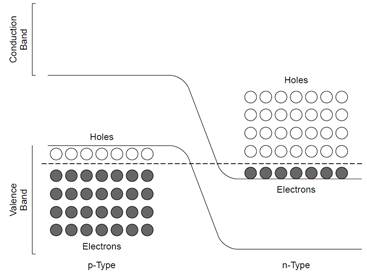
LASING MEDIUM
 المؤلف:
Mark Csele
المؤلف:
Mark Csele
 المصدر:
FUNDAMENTALS OF LIGHT SOURCES AND LASERS
المصدر:
FUNDAMENTALS OF LIGHT SOURCES AND LASERS
 الجزء والصفحة:
p313
الجزء والصفحة:
p313
 14-4-2016
14-4-2016
 1629
1629
LASING MEDIUM
Which produce light as a result of the recombination of electrons and holes in the active region, where a junction is formed between p- and n-type semiconductor materials. Diode lasers work in a similar manner, with the requirement of an optical cavity for feedback and, of course, conformity to the criteria for stimulated emission and laser gain (so that a laser diode is not simply an LED with a cavity).
Consider a simple p-n junction manufactured from a material doped to have excess holes and a material doped to have excess electrons. When a junction is formed with these two materials in equilibrium, a voltage develops that prevents electrons in the conduction band of the n-type material from diffusing across the barrier and combining with holes in the p-type material. When a voltage equal to this potential is applied across the device, current flows and electrons combine with holes, producing photons in the process.
In most laser diodes, degenerately doped semiconductor materials are used. Degenerately doped means that the Fermi levels (the statistical point where 50% of the electrons will be found) are actually within the valence (for p-type material) and conduction (for n-type material) bands themselves. Application of a voltage across the gap causes the Fermi levels for each type of material, aligned at equilibrium, to split into two distinct levels separated by the applied voltage. Electrons in the conduction band of the n-type material now lie just below the Fermi level of that material, and holes in the valence band of the p-type material lie just above the Fermi level of that material. An inversion is hence generated since there are more electrons in the upper energy band than in the lower band.
Of course, electrons and holes involved in the recombination process can lie anywhere in these bands, so a range of wavelengths are possible, with the longest wavelengths corresponding to the band gap energy. A sharp red cutoff is then expected on the spectral output curve of such a device. Emission on the blue side of the curve also has a limiting factor brought about by the nature of the material itself. Electrons are confined to bands, the top band being defined by the Fermi level for the n-type material and the bottom of the conduction band Ec, and the lower band being defined by the Fermi level for the p-type material and the top of the valence band Ev. Photons with energies corresponding to jumps within these bands encounter amplification by stimulated

Figure 1.1. Energy levels in a degenerate semiconductor.
emission since a population inversion exists, but when the energy of an incident photon exceeds the energy corresponding to the difference between the Fermi levels, it is absorbed rapidly by electrons in the valence band of the p-type material (not the holes at the top of that band) to promote these to the conduction band. The material is thus strongly absorbing at wavelengths shorter than the energy corresponding to the difference between the Fermi levels, as illustrated in Figure 1.1. Optical gain by stimulated emission can, therefore, occur only for photons with a specific range of energies. Shorter wavelengths are absorbed and longer wavelengths simply lack the energy to make the transition.
 الاكثر قراءة في بعض تطبيقات الليزر
الاكثر قراءة في بعض تطبيقات الليزر
 اخر الاخبار
اخر الاخبار
اخبار العتبة العباسية المقدسة


